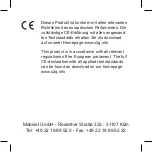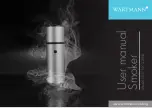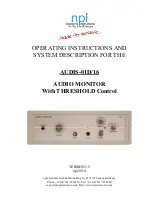
11
Amplifier to speaker connections
All connect ions should be made
with the amplif ier switched
OFF. Ensure the integrity of all
connect ions prior to switching
the amplif ier ON.
KEF Blade Meta speakers are
f it ted with purpose designed
silver-plated Bi-wire/Bi-amp
terminals which will accept bare
wire, spade or 4mm connectors.
Most good quality speaker
cables have some indicat ion,
such as colour coding or
‘ribbing’ on the insulat ing
l-|;ub-Ѵķbm7b1-ঞm]_b1_
conductor is ‘+’ or posit ive.
Connect ion to the speakers can
then be made as follows:
Bare wire connect ions are the
simplest to achieve and involve
stripping 12.5mm (0.5in.) of
insulat ion to expose the
speaker wire core. (You should
twist together, using clean
f ingers, the ends of each
mult i-stranded core prior to
the next stage to ensure
a good signal contact). Having
unscrewed the lower terminal
cap, push the wire through the
exposed hole in the terminal
body and screw the cap
down t ightly.
Make sure that no stray strands
come into contact with the
opposite terminal; this could
cause a short circuit between
the terminals and may damage
your amplif ier.
Be aware that a higher quality
run of cable will always give a
more rewarding presentat ion
than mult iple runs of an
inferior cable.
Installation and operation
The lef t channel amplif ier
output terminal marked ‘+’ or
coloured RED connects to the
lef t speaker terminal marked ‘+’.
The lef t channel amplif ier
output terminal marked ‘-’ or
coloured BLACK connects to
the lef t speaker terminal
marked ‘-’. Similarly, these
instruct ions should be followed
=oul-hbm]1omm;1ঞomv
between the right channel
amplif ier output and the right
speaker. Correct polarity, or
phase, is vital to the proper
operat ion of the system.
If the connect ions are not
made correctly the sound will
deteriorate giving poor
bass output and a dif fuse
presentat ion of the soundstage.
Amplifier requirements
and power handling
In KEF literature and in the
specif icat ion table within these
instruct ions are listed a range
of amplif ier power outputs to
match your Blade Meta
vr;-h;uvĺom7bঞomvo=v;
(room size, type of programme,
preferred listening level) and
the nature of the speaker/
amplif ier interface vary so
widely that it is not possible to
lay down hard and fast rules
about amplif iers and the
speakers they drive.
KEF speakers are built to
rigorous standards of quality
and consistency and the upper
Ѵblb|vo=|_;-lrѴbC;u
requirements shown are those
which the speaker in quest ion
should handle without distress
or damage when used under
moul-Ѵ7ol;vঞ11om7b|bomvĺ
Remember it is easier to
damage the speaker by using a
small amplif ier driven into
distort ion by too much volume,
possibly with bass and treble
boost, than by using a larger
amplif ier which has power in
reserve. If in doubt,
ask the advice of your retailer
or consultant.
Installation and operation
If higher than specif ied
amplif ier powers are used, great
care should be taken to avoid
abnormal condit ions such as
switch-on surges or gross
distort ion, either of the
amplif ier or the speaker,
result ing in power peaks greatly
in excess of the rat ings
specif ied. Care should be taken
as the possibility st ill exists
under certain condit ions (such
as excessive bass or treble
boost caused by tone and/or
loudness controls, graphic
equalisers, etc.) that the
speakers can be overloaded and
damaged. The lower limits of
amplif ier power are those
necessary to give a reasonable
sound pressure level under
domest ic condit ions.





























